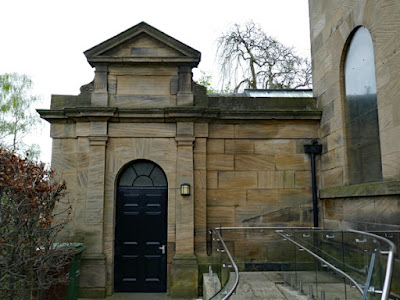Arriving in Horbury on the No.126 bus from Wakefield, I alighted at the High Street stop and walked up Queen Street to the Grade I Listed Church of St. Peter and St. Leonard, which was designed by the renowned architect John Carr and built between 1791 and 1793 at his own expense.
In Rotherham, I had encountered the Grade II* Listed Aston Hall (1772), Clifton House (1783) and St. James’ church (1756) in Ravenfield, as well as other country houses on my travels that he had substantially altered – the Grade I Listed Wentworth Woodhouse (1760-1804) and Heath Hall (1754-1780) and the Grade II* Listed Cannon Hall – and I was therefore not surprised to see that it is designed in the Classical style.
Except for the rustication on the first stage of the tower, which has four stages with a rotunda and spire, the fabric is built with sandstone ashlar and tall rounded windows and, except for the portico with its Ionic columns, nothing much caught my eye as I walked anti-clockwise around the exterior.
On the east end, a motif in the form of a stylised cross is carved into one of the ashlar blocks, which has the letters AVG inscribed to the top left corner and the number 28 and possibly others in the right top corner, but I don’t know what its significance is.
Returning to the south elevation, the pediment to the portico contains a Latin inscription, which records that the church was built by the architect John Carr at his own expense in 1791. I tend not to take as much notice of Ionic capitals as the Corinthian order, but here they incorporate intricate egg and dart mouldings and acanthus leaves.
The main reason for wanting to visit this church was because it provides a spectacular example of the use of the Woolley Edge Rock, a coarse grained sandstone from the Upper Carboniferous Pennine Middle Coal Measures Formation.
Where I have seen it used in Wakefield Cathedral, the Chantry Chapel of St. Mary, Sandal Castle and St. Helen’s church in Sandal Magna, it has very well defined cross-bedding, where beds of iron rich sediment with a purplish colour give it a very distinctive striped appearance.
The Horbury History and the Wild West Yorkshire websites both refer to the stone as Dam Stone, which was apparently the same stone used to build at least the barbican at Sandal Castle. The geological memoir (1940) refers to the Woodmoor quarries at Newmillardam supplying stone for the restoration of Wakefield Cathedral, which has the same colour and texture and I therefore presume that the stone for the church came from here too.
I didn’t notice at the time but the walling of south chapel, which was was added in 1920, contains a mixture of striped Woolley Edge Rock and a uniformly pale buff coloured massive sandstone. The condition of the sandstone throughout the fabric is good and I couldn't see any signs of restoration and I therefore can't give an obvious explanation for this.
Moving round to the north side of the church, I took a couple of photos of the north elevation at a distance and then got talking to a couple of visitors who had a copy of the latest edition of Pevsner, in which it mentions that Carr – who had started working in his father’s quarry as a stone mason before becoming an architect - deliberately chose this stone for effect.
Up to this point, although an online search before my visit confirmed that the church would be open, I had wondered if this was in fact correct because I thought that the locked south door would be the entrance and I saw no lights on; however, these visitors pointed out the entrance on the north side and, before having a look at the interior, I took a photo of the vestry (1884).
























































